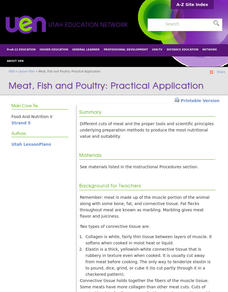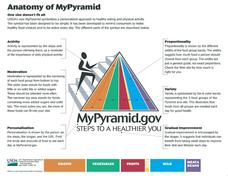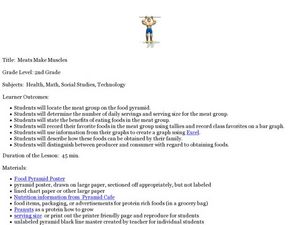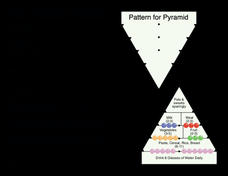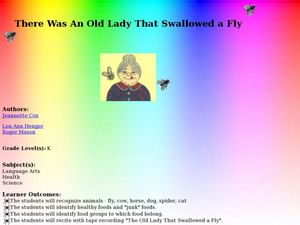Curated OER
Meat, Fish and Poultry: Practical Application
A note-taking outline is given to learners which covers meat composition and quality, types of meat and storage, and cooking meat. By viewing pictures they learn to identify cuts of meat or poultry products. They discuss inspection and...
Elementary CORE Academy
Food Foldable
There's nothing as satisfying as a crunchy carrot or a juicy apple! Teach your middle and high schoolers about healthy eating habits with a set of nutrition activities. After analyzing the model of the food pyramid, learners apply the...
Curated OER
Junk Food Jungle
Students become familiar with the nutritional value of foods advertised on television and in magazines. They discuss different types of foods and where snack food fits into a healthy diet. They categorize the foods they eat as healthy or...
Curated OER
Meats Make Muscles
Second graders explore the meat group of the food pyramid. For this nutrition and diet lesson, 2nd graders study the benefits of eating foods in the meat group, collect data regarding their classmates' favorite foods, and create a graph...
Nemours KidsHealth
Food Safety: Grades 9-12
Food poisoning, salmonellosis, E. Coli, shigellosis, tapeworms—all these words can strike fear into eaters. Alas, the five-second rule is not necessarily true! Two activities teach teens safety rules for food purchasing, preparation,...
Curated OER
Food Pyramid
Students construct food pyramids by painting shoe boxes and using them to respresent different food groups. They cut out and paste pictures of the respresentative foods for the groups on the box sides. They compare their diets to the...
Curated OER
The Food Connection
Students examine the connection between the foods on the food pyramid and agricultural products. They identify the food groups, discuss foods from each group, complete two handouts, and construct a desktop food pyramid, placing foods in...
Curated OER
Cut and Paste Food Chain
Young scholars study life science. For this food chain lesson, students discover the different types of animals that make up an ecosystem. They discuss as a class and then work independently on a food chain activity. This lesson includes...
Curated OER
Where Does Food Come From?
Distinguish between food and non-food items. Recognize that food is obtained from both plant and animal sources. Identify sources for some common animal foods then construct a simple food path from the farm to the consumer.
Curated OER
Build a Burger
Here is an outstanding lesson on food groups, nutrition, and diet. In it, learners focus on hamburgers! They take a close look at the products that go into making a hamburger, conduct taste tests on samples, discuss the nutritional value...
Curated OER
Food Chains
Fourth graders study food chains, producers, consumers, and decomposers. They play a food chain game and create food chain mobiles or posters. They take a nature hike around the school and observe various parts of a food chain.
Curated OER
Raid the Food Pantry
Students explore the food groups represented on the food pyramid. In this nutrition and physical education lesson, students participate in a game in which teams try to grab a play food object designated by the teacher and return it to...
Curated OER
Food Pyramid Quiz
In this food groups worksheet, students insert the number of servings needed for each of the six groups. Students also classify the given list of foods in the appropriate group.
Curated OER
Introduction to the Food Pyramid
Students review information on the food pyramid, either in printed works or on the Internet, to research healthy eating habits.
Curated OER
Food Web Mobile
Students explain the main concepts of food webs and food chains. They
describe the role of animals, plants, and other organisms in cycling energy and matter through a food web by creating mobiles. Lesson contains adaptations for all levels.
Curated OER
Food Pyramid and Dietary Guidelines
Students examine Food Guide Pyramid and Dietary Guidelines. They look at samples of serving sizes, sort different foods into their correct groups, complete worksheets to discover which types of foods they eat regularly, and discuss...
Curated OER
Food Pyramid Abacus
Students examine the importance of eating a healthy balanced diet. They read and discuss an article about the Food Guide Pyramid, and construct a Food Pyramid Abacus.
Curated OER
King Henry's Meat Group
Second graders hear a story about King Henry the Egg, Little D and the meat group. They act out the parts as the story is read aloud and complete a worksheet. They pantomime activities that use and build muscle
Curated OER
Hazards of Defrosted Food
Peas spoilage hot, peas spoilage cold: examine the bacterial growth on newly defrosted peas versus peas that have been defrosted for 24 hours. Using the session one questions in the "Microbes and Food Spoilage" PDF, learners will make...
Curated OER
Energy Plus!
"Energy Plus!" from Together Counts is three days worth of lessons, discussions, and activities about nutrition. The materials help you teach youngsters about eating healthy and burning calories. Energy in and energy out. Included are...
Curated OER
There Was An Old Lady That Swallowed a Fly
Students complete activities with the book There Was An Old Lady That Swallowed a Fly. In this literature lesson plan, students hear the story and recognize the animals. They create fly soup and discuss healthy foods and...
Curated OER
PICTURE PERFECT PYRAMID
Middle schoolers create a model of the USDA's Food Pyramid Guide, using shoe boxes. They bring an assortment of shoe boxes from home. Students are given a copy of the "Food Guide Pyramid." They wrap boxes for the bread group in white,...
Curated OER
Food For Energy - Four Food Groups
Students consider how food is converted to energy. In this science lesson plan, students explore the importance of eating properly with a balanced diet as they study 4 food groups.
Curated OER
Meet the Royal Food Family
Second graders use mini-books, posters, songs, trading cards and sorting activities to explore the five food groups needed for health: vegetables, fruits, grains, milk and meat. They discuss why good nutrition is important.


